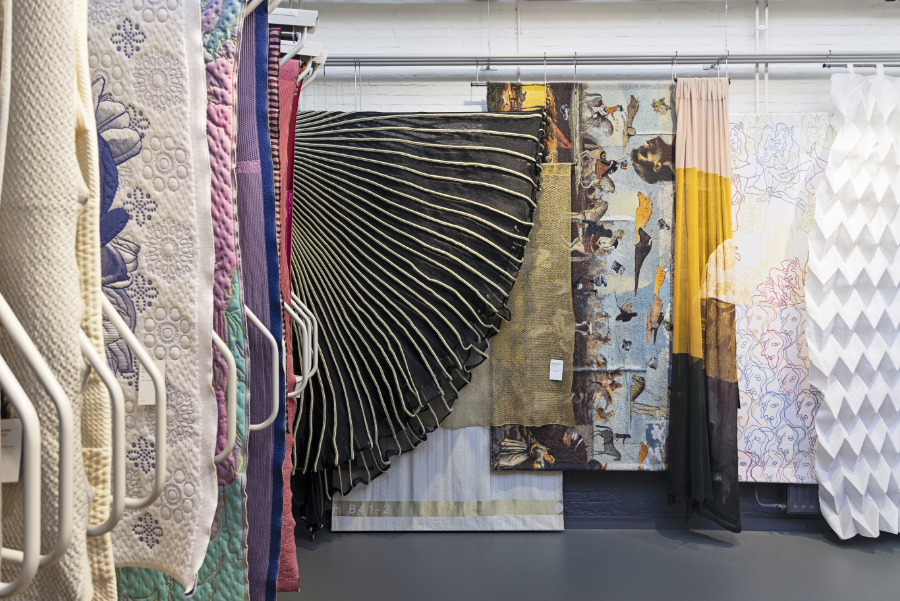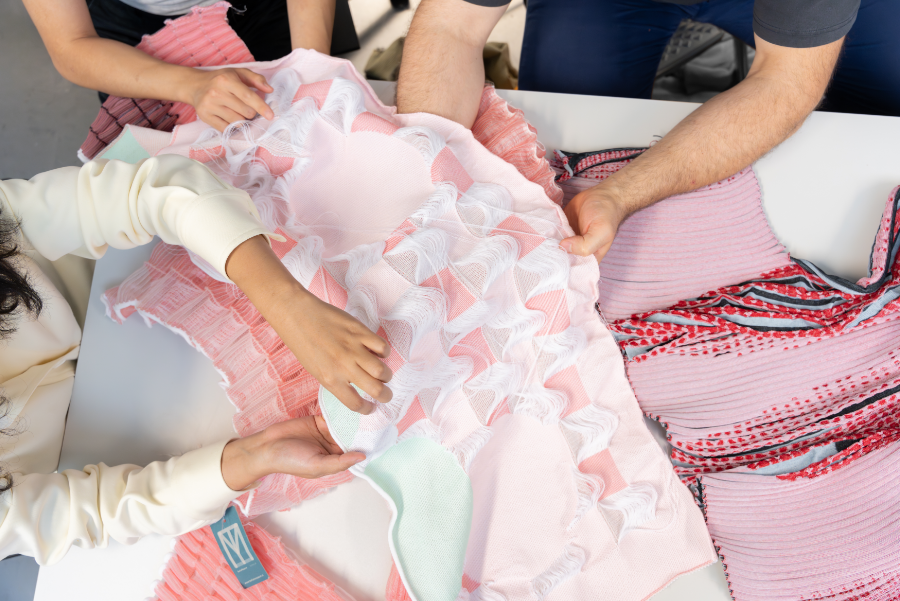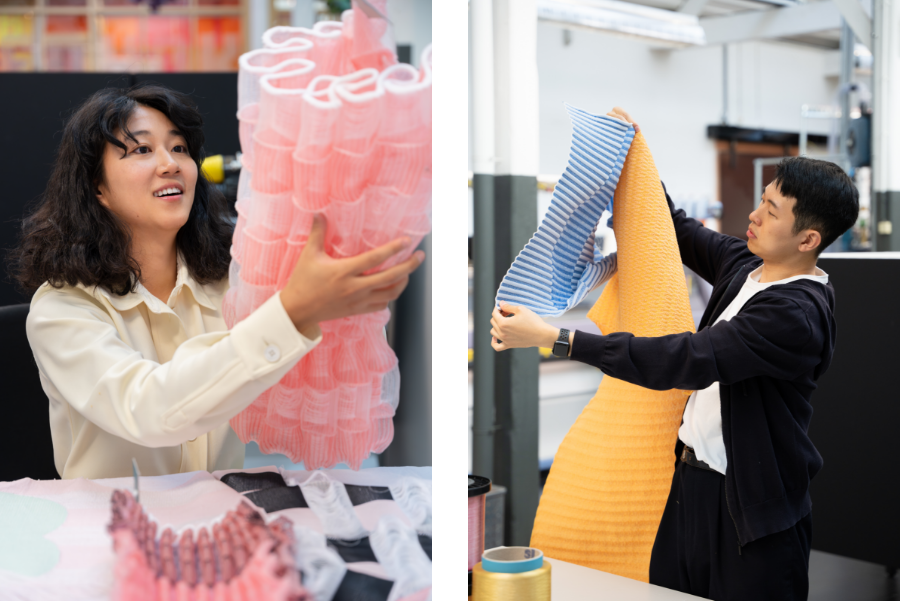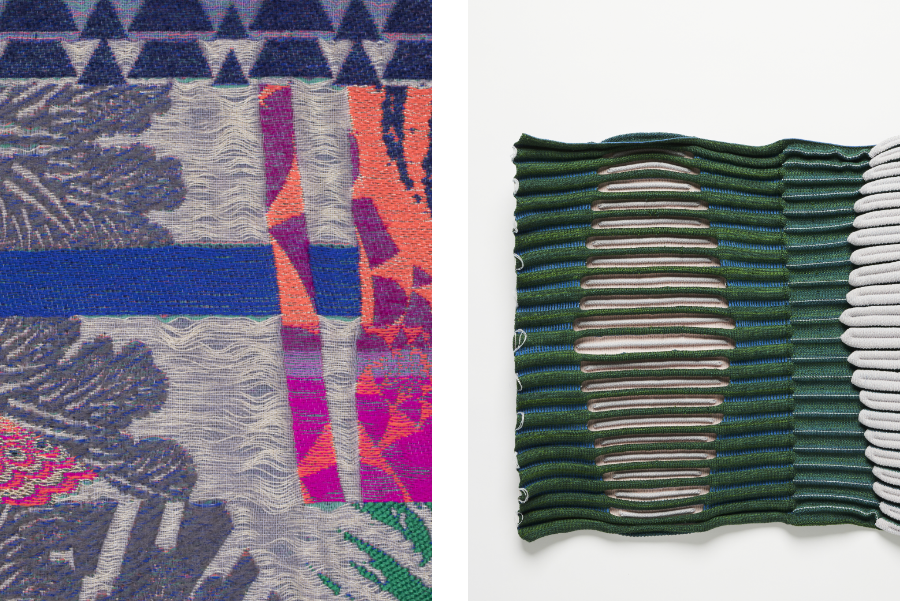Almost 30 new samples have been selected for the Sample Studio, which makers can use when developing their own project. “These samples are really important, especially in the initial phase,” says knitting artist Yu-Mei Huang, who was inspired earlier this year by several samples for her 3D-knitted Soft Sculptures.
Talking about knits and weaves is much easier when you have tangible examples to hand. That’s where the Sample Studio, which boasts more than 500 samples, comes in. Makers often start by browsing through the online studio during the initial intake session with the product developer. The samples, which are described in detail, are used to clarify a maker’s vision. If the TextielLab accepts the assignment and the maker is on site, the physical Sample Studio is mainly used during development, when you can literally run the samples through your hands. “It’s quite difficult to explain in words what you mean when it comes to something as technical and tactile as weaving and knitting,” says Noortje van den Elzen, Research & Development Manager at the TextielLab. The samples help to make the words concrete, including for those who are new to knitting and weaving. You can see and feel how a certain weave or stitch affects a specific yarn, and you can indicate what you like or want to do differently. The samples are therefore not only a source of inspiration; they are also valuable talking points for the maker’s practice in the lab.

Tangible examples of samples in the Sample Studio. Photo: Josefina Eikenaar
“The Sample Studio is really important in the initial phase of a project.”
Yu-Mei Huang
Soft Sculptures
“The samples are a great starting point for a new project,” agrees textile artist Yu-Mei Huang, who worked with the TextielLab’s knitting experts for the first time this year. “Instead of trying 100 different things, you can use the physical examples to examine the material and texture. It saves a lot of time.” Huang worked in the lab in February and June on Soft Sculptures, a series of sculptural knits that combine elements of body art and spatial design. The project explores the interaction between textiles, body and space and breaks down the system of fixed sizes and shapes. “The prevailing sizing system is unsustainable and not very wearer-friendly,” says Huang, whose Soft Sculptures are so flexible that they can conform effortlessly to different body types or spaces.

Samples for Yu-Mei Huang’s Soft Sculptures: ‘The Fold’, ‘Wall piece’ and a kimono. Photo: Patty van den Elshout
Bubble wrap
Huang is not new to knitting, so she was able to skip the lab’s knitting knowledge clip covering the basics. However, the Sample Studio provided inspiration for how to approach the three works – an object, a garment and six wall hangings – which she will finalise in January. When she started talking about the structure of bubble wrap, product developer Yani Chuang showed her the sample of Sangmin Oh’s latest ‘Knitted Light’. Huang loved the sculptural look of this and decided to use a similar technique to develop an object with the working title ‘The Fold’. This gracefully pleated, stretchy structure is knitted, like Oh’s lamps, with polyester monofilament and elastic, resulting in a sturdy but highly flexible and resilient construction. But Huang wanted a less compact, more transparent effect, to give the result an airy, lightweight look. She also added her own monofilament to achieve a specific shade of salmon pink.

Yu-Mei Huang with her samples in the lab. Photo: Patty van den Elshout / Sangmin Oh with samples for his work ‘Knitted Light’. Photo: Patty van den Elshout
Road markings
For the other Soft Sculptures, Huang was inspired by several other samples. The design for the knitted one-size-fits-all kimono with three-dimensional pleats was already quite well developed when she arrived in the lab. But the 3D knitted fabrics for Robin Pleun Maas’ Archive of the Future project that she saw in the Sample Studio confirmed she was heading in the right direction. With the product developers, Huang used an innovative ‘plaiting’ technique to knit the complex colour pattern into the kimono instead of printing it on the fabric afterwards, as she initially planned to do. For the six tapestries, she looked to Kustaa Saksi’s Anius Myth Series, Jef Montes’ ‘Marinero’ and Marilene Madou’s textured cushions. “I don’t find plain jacquard knitting that interesting,” she says. “Something special has to happen.” And it has: the use of innovative techniques created striking floats and distinct textures, patterns and colours, based on the road markings that Huang saw in Tilburg.

Sample by Kustaa Saksi. Photo: Tommy de Lange / Sample by Robin Pleun Maas. Photo: Tommy de Lange
New samples selected
All of Huang’s pieces will be shown in the coming year in a performance at her solo exhibition in Taiwan and during the London Design Festival. A sample from this project might also find its way into the Sample Studio in the future, as a source of inspiration for others. The studio is expanded each year with new samples that fill technical and aesthetic gaps in the existing collection. If necessary, the samples are remade, photographed and documented. The online Sample Studio contains photos and technical details of all the physical examples that can be found in the room next to the lab. The lab team recently selected 29 samples from projects completed in 2023: from the woven wall coverings for Carré theatre in Amsterdam by Bas van Beek and a woven tribute to exploited women by patricia kaersenhout to the fully fashioned ceramic moulds by Brian Anderson and the circular-knitted migraine hoodie by Laura Deckwisch. The new additions will be available in the Sample Studio sometime next year.
Text: Willemijn de Jonge